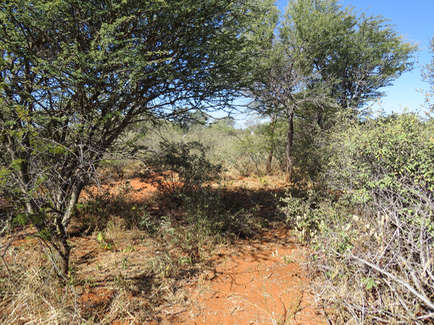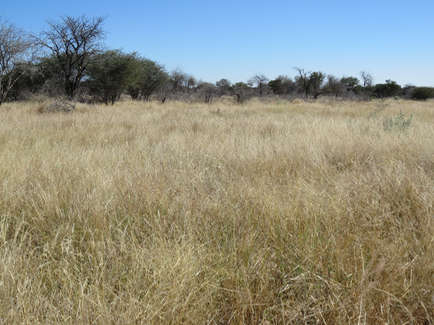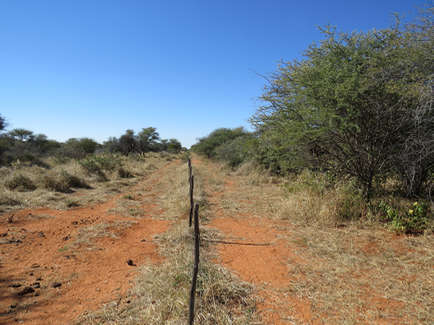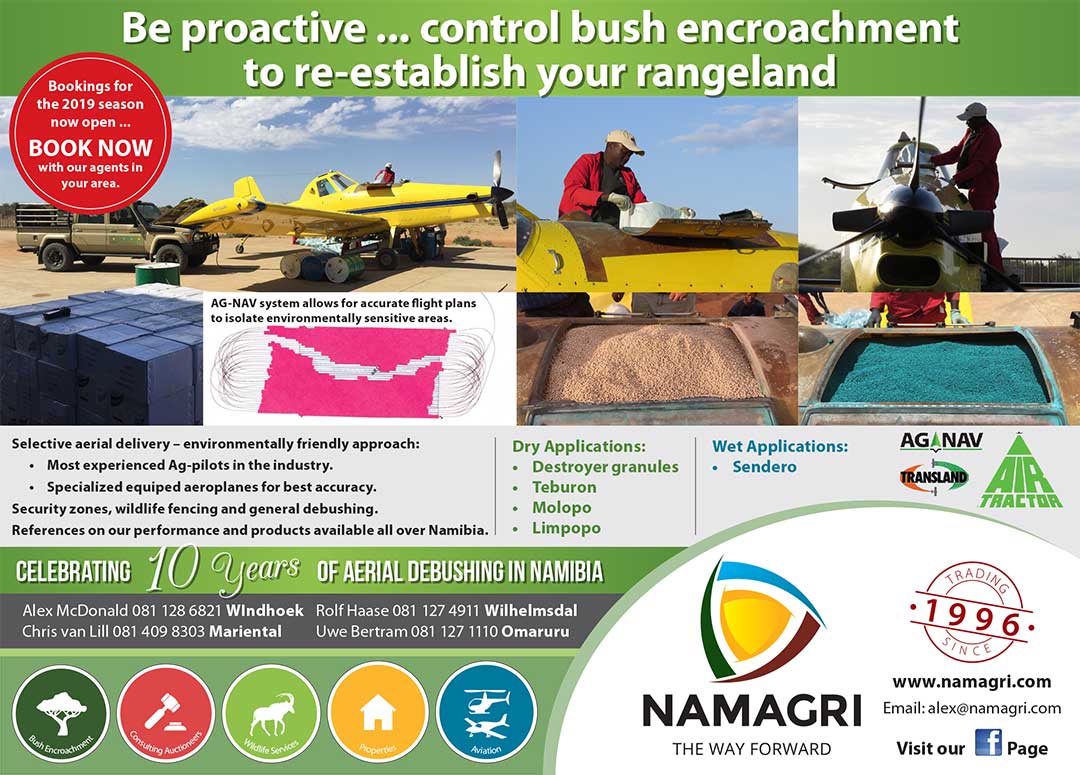The way forward
Namagri is your professional choice with over ten years debushing experience.
We can assure you of excellent service and advice to help you taking your land back.
Take back your land
Bush encroachment has a serious impact on your land by denying you access to the fullest potential your land can deliver. It has been said that Namibia loses billions of dollars each year to bush encroachment. Don’t you think it is time you took back your land? Namagri has a proven solution to your bush problem with the range of Destroyer products.
Namagri’s Destroyer debushing products have one clear goal to safely and efficiently return your land to a usable state. What does this mean? Unlike burning or cutting Namagri’s Destroyer products attack the problem long term by getting to the root of the problem. Cutting and burning only remove the bush above the soil and the root systems stay in place. As these root systems are very wide spread the bush recovers very soon. Many of Namagri’s debushing customers have enjoyed bush free land for nearly ten years.
There are many reasons and methods to the bush encroachment problem. Namagri’s focus is very specific to a scientific chemical approach to return the land to a state where it may be utilized. Namagri’s Destroyer solutions eliminate the targeted species from roots to bush. After the successful application it may be necessary to do a follow-up treatment after two seasons to treat the new growth from existing seedlings. If your goal is to harvest the bush for ongoing biomass projects or charcoal production the Destroyer solutions are not for you, as there will be no regrowth of the target species for many seasons.
Years of successful debushing
Farms Served
Species targeted by Destroyer



Frequently Asked Questions
What plant species do the Destroyer products eradicate?
Have a look the the Species List here that the Destroyer products are designed to eradicate.
How is the active ingredient activated?
Rainfall of between 10-20mm will dissolve the granule and leach the active ingredient into the soil where it is available for plants/bushes to absorb it through their root systems.
How long will it take to see results after application?
Within 3-4 weeks after approximately 20mm rain was received on the product the leaves on affected bushes will get a light lime green colour. This is the start of the end and the bush will defoliate a few times and expend its energy and die.
What if my washing machine dumped some active ingredients on my orange/lemon trees at the house?
Some documented cases exist that large quantities of sugar can neutralize some effects if applied very early in the process. This must be considered as anecdotal information.
Is double the dose better?
Every listed specie has it’s own dosage that was tested in Namibia and approved by the Ministry of Agriculture, Water and Forestry: Remedy Registrations.
Should the dosage be too high the grass regrowth will be affected and the first season will produce barren spots where the granules was applied.
If the correct dosage was applied absolutely no effect will be shown by the grass exept vigorous growth due to moisture availibility.
What is the difference between a granular vs liquid application?
Granules – Wastage less, Training easy, Spills can be reversed.
Liquid – Need syringes for accurate dosage, Many workers are already trained to use syringes.
What are the cheapest way to apply the product?
Three methods exist to apply granules.
By Hand – Labour intensive, Social challenges exist to provide food, housing, transport etc. People miss small seedlings that grow back quicker. Aftercare to follow sooner. Spot coverage applied.
By using a small fertilser spreader mounted on the back of a vehicle. Only areas accessible by vehicle can be covered such as roads and fencelines.
By Aeroplane – Accurate, Quick, Spray Report give feedback on exactly what area was covered. Small seedlings also affected by area coverage.
What is the smallest area I can cover with the aeroplane?
The aeroplane hopper take 1Ton of product per trip that convert into 200Ha applied @ 5Kg/Ha. The 5kg/Ha is an average used accross Namibia for most Acacia species. Smaller areas are not economical viable except when neighbours band together to increase Ha’s.
Can I get soil erosion after debushing?
Ussually the bushes absorb the first 150-200mm of rain due to their root hair cells having lower osmotic pressure than most grasses. This causes osmosis of moisture to happen easier and quicker for the bushes than for grass. This has the effect that no or few grasses grow underneath a bush and thereby it is protecting itself against hot veldfires. If no bushes exist the ground moisture will exist for the grasses to grow from the first 10mm of rainfall. If it should happen that a drought comes along wind erosion will definately be in effect. Without bushes you however have a build in buffer against droughts (should you farm conservatively and not overutilize the abundant grass) by converting rainfall into grass from 1mm and not only from 150mm going upwards.
What is the aftercare or follow-up period?
It depends on a lot of different factors:
Was the grazing methods adjusted that caused bush thickening?
What type of soil is in the area? Clay will bind strongly with the active ingredients and have it available for a longer period than for example sandy soils.
Sandy soils will leach the active ingredients deeper and quicker than clay soils.
Is seed blown into the treated area from untreated areas.
With more grass available fire becomes a viable option to reduce regrowth.
Can it be found in meat/milk/grass or urine?
Other active ingredients was found by the EU in meat/milk/grass or urine and banned all chemicals in the Agriculture Environment for a few months early in 2018. Bromacil is a cheap agressive ingredient banned worldwide Our products only used approved Tebuthiuron ingredients. Because bromacil is a possible human carcinogen and systemic toxicity may result from intermediate exposure (one week to several months), U.S. Environmental Protection Agency (EPA) assessed risk to workers using several major exposure scenarios.
How fatal is it for game, wildlife or domestic animals?
These chemicals are arboricides that disrupts photosynthesis and is not a poison. It is harmless to warmblooded organisms but may affect fish.
Directions for use
- DO NOT apply this product to salt or erosion prone areas.
- DO NOT apply this product within 100 metres of a recognised water course.
- DO NOT apply Destroyer on land with a slope greater than 20 percent (11 degrees).
- DO NOT apply Destroyer under conditions which will cause pellet movement to non-target areas during application.
- RETAIN at least 20 percent of the original tree population in wildlife corridors that are at least 100 metres wide. These are essential for shade and protection of livestock and native fauna. Ideally, shelter belts should traverse variableterrain, particularly ridgelines and hill tops as well as water courses, and link other vegetated corridors where possible.
- FOR LONG TERM VIABILITY retain a minimum of 5 hectares for shade areas, regardless of vegetation type.
- DO NOT apply Destroyer on field crops, near desirable trees or shrubs or to areas into which their roots may extend or in locations where the chemical may be washed into contact with their roots as injury or death may occur.
- DO NOT apply Destroyer to land to be put under field crops within 5 years of application.
General Usage
- Destroyer may be applied at any time of the year.
- Treatments become effective after sufficient rainfall has occurred to move the chemical into the root zone where absorbed by woody plants.
- Applications just prior to seasonal rainfall give the most rapid response.
- Herbicidal activity continue for several seasons after application.
- During this time woody plants may go through repeated defoliation’s and regrowth until death occurs.
- A single application is normally effective for several years.
- Forage grass production usually increases as woody weed competition is reduced.
- Increased grass production is also dependent on adequate rainfall an acceptable grazing management programme.
- It is important to allow grasses to seed and seedlings to become established after treatment before grazing pressure is increased.
- Areas treated with Destroyer may be over seeded with suitable pasture species.
- Consult your agricultural specialist for details on suitable seeding rates, timing and fertilizer application programme.
- The residual action of Destroyer may be impaired if fire occurs before the pellets are dissolved and the chemical has moved into the root zone.
Treating Individual Trees & Fence Lines
Treating Individual Trees
Estimate the area within 30 cm beyond the drip zone, i.e. the area under the plant canopy. It is essential that this area is treated as evenly as possible with pellets being spread from the tree trunk to slightly beyond the drip line formed by the branches.
Do not throw all the pellets at the base of the tree trunk. This will waste material and could result in poor control.
Treating Fence Lines
Estimate the area to be treated, along the fence line and then apply Destroyer pellets on both sides of the fence line as evenly as possible.
The Material Data Safety Sheet is available as PDF here.
Contact Us
| Name | Area | Phone |
| Alex McDonald | Windhoek | 081 128 6821 |
| Chris van Lill | Mariental | 081 409 8303 |
| Rolf Haase | Wilhelmstal | 081 127 4911 |
| Uwe Bertram | Omaruru | 081 127 1110 |
